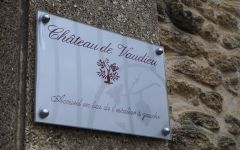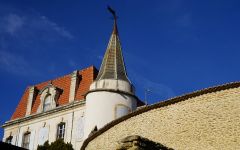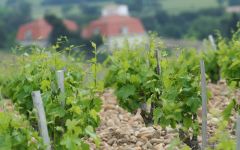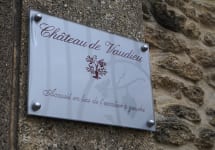Chateau de Vaudieu Chateauneuf-du-Pape Clos du Belvedere Blanc 2019
-
Jeb
Dunnuck -
Robert
Parker - Decanter
-
Wine
Spectator



Product Details
Your Rating
Somm Note
Winemaker Notes
Chateau de Vaudieu Chateauneuf-du-Pape Clos du Belvedere Blanc is a pale gold crystal color with green highlights. The nose is extremely rich: grapefruit and rifle stone at the beginning it evolves towards aromas of stone fruits. In the mouth, the attack is lemon and then the fat takes over and coats the palate, to return to the final on the mineral notes that give it a nice length.
Professional Ratings
-
Jeb Dunnuck
The 2019 Châteauneuf Du Pape Clos Du Belvédère Blanc checks in as 100% Grenache Blanc, all from a single parcel of vines around the estate. Brought up all in older barrels, it offers a Grand Cru white Burgundy-like bouquet of caramelized orchard fruits, white currants, wood smoke, scorched earth, and a beautiful sense of minerality. The purity is just about off the charts in this magical wine, which hits the palate with full-bodied richness, a beautiful spine of acidity, flawless balance, and a great finish. It’s unquestionably one of the greatest whites I’ve tasted from the estate and is quite possibly the wine of the vintage in 2019 whites.
-
Robert Parker's Wine Advocate
All old-vine Grenache Blanc grown on galets roulés and red clay, the 2019 Chateauneuf du Pape Blanc Clos du Belvedere boasts remarkable freshness and verve allied to ample weight and concentration. Scents of mixed citrus mark the nose, while the medium to full-bodied palate delivers scintillating notes of tangerine and lime, plus some gently herbal notes on the long, vibrant finish. It's clearly one of the best varietal Grenache Blancs to have passed this taster's lips, but I would suggest drinking it over the next several years to be sure to catch it in its youthful splendor.
-
Decanter
This shows just how well Grenache Blanc can communicate and transmit minerality. Searing freshness and great mineral grind with a beautifully fresh citrus bite. Surely one of the best pure Grenache Blancs in the world. 2,600 bottles made. Pure Grenache Blanc grown on galets roulés in lieu-dit Vaudieu, fermented and aged in old barriques.
-
Wine Spectator
Really tasty, with delightfully pure and expressive honeysuckle and jasmine notes leading the way for white peach, green melon and yellow apple fruit flavors. Light kiss of brioche on the finish.
Other Vintages
2011-
Robert
Parker







Located about a five minute drive outside the village of Chateauneuf-du-Pape along the road which leads to Courthezon you will find Chateau de Vaudieu. It is one of three 18th century Chateaux located in the appellation, tucked into a small valley surrounded by hills and plateau. It is at the intersection of several major terroirs: sandy soils to the north, along a border it shares with Chateau Rayas (one of the best wines in Chateauneuf-du-Pape but not actually a Chateau), pale limestone and clays centered around a forested hillock, and two large plateaux of the somewhat overexposed galets. In total there are 70 hectares within one contiguous estate – something very rare in the appellation.

Full-bodied and flavorful, white Rhône blends originate from France’s Rhône Valley. Today these blends are also becoming popular in other regions. Typically some combination of Grenache Blanc, Marsanne, Roussanne and Viognier form the basis of a white Rhône blend with varying degrees of flexibility depending on the exact appellation. Somm Secret—In the Northern Rhône, blends of Marsanne and Roussanne are common but the south retains more variety. Marsanne, Roussanne as well as Bourboulenc, Clairette, Picpoul and Ugni Blanc are typical.

Famous for its full-bodied, seductive and spicy reds with flavor and aroma characteristics reminiscent of black cherry, baked raspberry, garrigue, olive tapenade, lavender and baking spice, Châteauneuf-du-Pape is the leading sub-appellation of the southern Rhône River Valley. Large pebbles resembling river rocks, called "galets" in French, dominate most of the terrain. The stones hold heat and reflect it back up to the low-lying gobelet-trained vines. Though the galets are typical, they are not prominent in every vineyard. Chateau Rayas is the most obvious deviation with very sandy soil.
According to law, eighteen grape varieties are allowed in Châteauneuf-du-Pape and most wines are blends of some mix of these. For reds, Grenache is the star player with Mourvedre and Syrah coming typically second. Others used include Cinsault, Counoise and occasionally Muscardin, Vaccarèse, Picquepoul Noir and Terret Noir.
Only about 6-7% of wine from Châteauneuf-du-Pape is white wine. Blends and single-varietal bottlings are typically based on the soft and floral Grenache Blanc but Clairette, Bourboulenc and Roussanne are grown with some significance.
The wine of Chateauneuf-du-Pape takes its name from the relocation of the papal court to Avignon. The lore says that after moving in 1309, Pope Clément V (after whom Chateau Pape-Clément in Pessac-Léognan is named) ordered that vines were planted. But it was actually his successor, John XXII, who established the vineyards. The name however, Chateauneuf-du-Pape, translated as "the pope's new castle," didn’t really stick until the 19th century.
